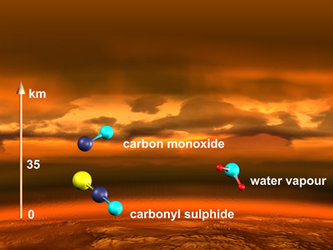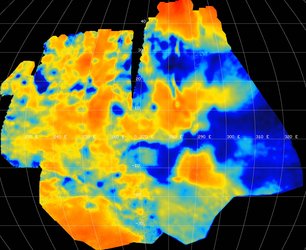Venus Express seeks out gases below the clouds
ESA’s Venus Express has recently ‘peeled back’ the thick clouds around Venus to provide the most accurate and wide-ranging map of water vapour and other gases in the lower atmosphere to date.
As a planet, Venus does not radiate a significant amount of visible light. But because of the searing temperatures below its thick cloud layer, reaching 200°C at an altitude of 35 km and more than 450°C at the surface, there is great deal of infrared radiation coming from beneath.
At certain wavelengths, or infrared ‘windows’, this radiation can pass through the thick clouds, carrying information on what lies below. For example, its intensity, and how it peaks or dips at certain wavelengths, can tell us a lot about the composition of the atmosphere.
Thanks to the unique ability of its VIRTIS spectrometer to use these spectral windows, Venus Express has mapped the atmosphere over many orbits and has covered the lower atmosphere for the first time.
The atmosphere of Venus is dominated by carbon dioxide but as VIRTIS looked on, it detected the signature of carbon monoxide, an unusual find in the planet’s deep atmosphere. Looking further, in higher resolution, scientists also found carbonyl sulphide and water vapour. Since the early 1980s these molecules were known to exist on Venus, but before Venus Express they had never been measured and mapped so extensively and accurately.

Carbon monoxide is such a rarity on Venus that it can be used as a tracer to monitor circulation patterns in the atmosphere. It is like studying the flow of fluorescent ink dropped into a liquid to reveal the circulation pattern in the liquid itself.
The presence of carbonyl sulphide is usually linked to carbon monoxide: wherever there is abundant carbonyl sulphide, there will be little carbon monoxide and vice versa. Past observations have already suggested that this is the case, and VIRTIS has mapped the distribution with greater accuracy.
The results confirm what meteorological models have shown: that such an inverse relationship between the abundances of molecules is due to the large-scale circulation of the atmosphere. The air rises at the equator to higher altitudes and moves towards higher latitudes, both north and south, where it descends, transporting the gases as it goes along.
The existence and abundance of water vapour in Venus’s atmosphere has been a subject of debate for many years because the molecule is very difficult to monitor in the lower atmosphere from space. Venus Express has now detected and measured and mapped the amount of water vapour in the lower atmosphere, with unprecedented spatial resolution.
Notes for editors:
The findings have been reported in ‘Variability of CO, OCS And H2O Below The Clouds of Venus From VIRTIS-H Night-side Spectra,’ by E. Marcq, B. Bezard, P. Drossart, G. Piccioni and the VIRTIS Team, presented at the American Astronomical Society’s Division of Planetary Sciences meeting in October 2007.
For more information:
Pierre Drossart, Observatoire de Paris, France
Email : Pierre.Drossart @ obspm.fr
Giuseppe Piccioni, IASF-INAF, Italy
Email : Giuseppe.Piccioni @ iasf-roma.inaf.it
Håkan Svedhem, ESA Venus Express Project Scientist
Email : Hakan.Svedhem @ esa.int















 Germany
Germany
 Austria
Austria
 Belgium
Belgium
 Denmark
Denmark
 Spain
Spain
 Estonia
Estonia
 Finland
Finland
 France
France
 Greece
Greece
 Hungary
Hungary
 Ireland
Ireland
 Italy
Italy
 Luxembourg
Luxembourg
 Norway
Norway
 The Netherlands
The Netherlands
 Poland
Poland
 Portugal
Portugal
 Czechia
Czechia
 Romania
Romania
 United Kingdom
United Kingdom
 Slovenia
Slovenia
 Sweden
Sweden
 Switzerland
Switzerland






































